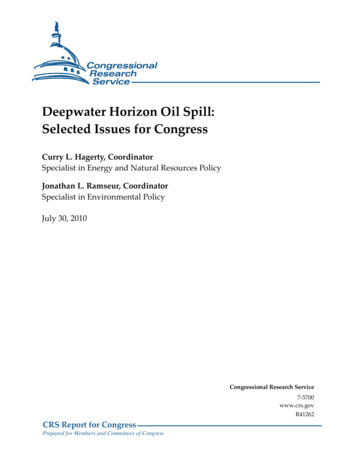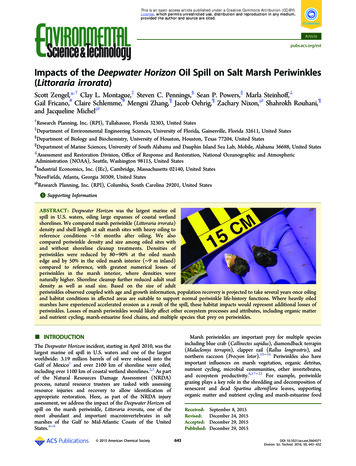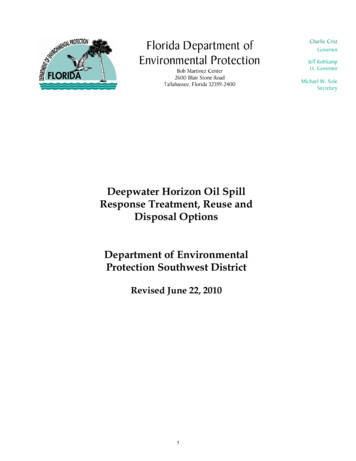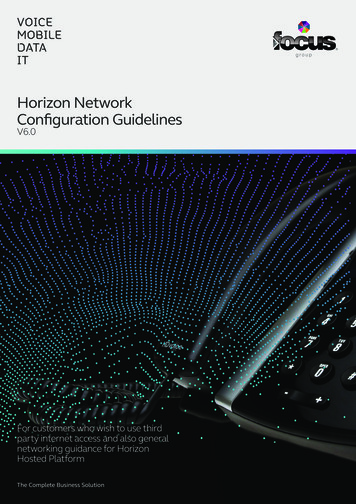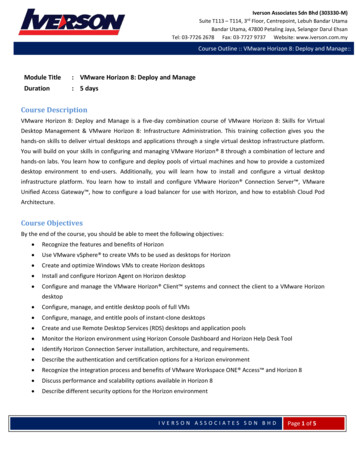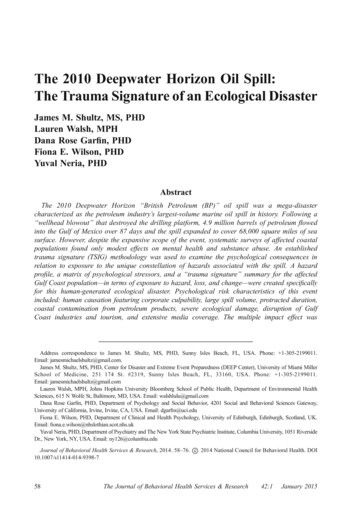
Transcription
The 2010 Deepwater Horizon Oil Spill:The Trauma Signature of an Ecological DisasterJames M. Shultz, MS, PHDLauren Walsh, MPHDana Rose Garfin, PHDFiona E. Wilson, PHDYuval Neria, PHDAbstractThe 2010 Deepwater Horizon “British Petroleum (BP)” oil spill was a mega-disastercharacterized as the petroleum industry’s largest-volume marine oil spill in history. Following a“wellhead blowout” that destroyed the drilling platform, 4.9 million barrels of petroleum flowedinto the Gulf of Mexico over 87 days and the spill expanded to cover 68,000 square miles of seasurface. However, despite the expansive scope of the event, systematic surveys of affected coastalpopulations found only modest effects on mental health and substance abuse. An establishedtrauma signature (TSIG) methodology was used to examine the psychological consequences inrelation to exposure to the unique constellation of hazards associated with the spill. A hazardprofile, a matrix of psychological stressors, and a “trauma signature” summary for the affectedGulf Coast population—in terms of exposure to hazard, loss, and change—were created specificallyfor this human-generated ecological disaster. Psychological risk characteristics of this eventincluded: human causation featuring corporate culpability, large spill volume, protracted duration,coastal contamination from petroleum products, severe ecological damage, disruption of GulfCoast industries and tourism, and extensive media coverage. The multiple impact effect wasAddress correspondence to James M. Shultz, MS, PHD, Sunny Isles Beach, FL, USA. Phone: 1-305-2199011.Email: jamesmichaelshultz@gmail.com.James M. Shultz, MS, PHD, Center for Disaster and Extreme Event Preparedness (DEEP Center), University of Miami MillerSchool of Medicine, 251 174 St. #2319, Sunny Isles Beach, FL, 33160, USA. Phone: 1-305-2199011.Email: jamesmichaelshultz@gmail.comLauren Walsh, MPH, Johns Hopkins University Bloomberg School of Public Health, Department of Environmental HealthSciences, 615 N Wolfe St, Baltimore, MD, USA. Email: walshlulu@gmail.comDana Rose Garfin, PHD, Department of Psychology and Social Behavior, 4201 Social and Behavioral Sciences Gateway,University of California, Irvine, Irvine, CA, USA. Email: dgarfin@uci.eduFiona E. Wilson, PHD, Department of Clinical and Health Psychology, University of Edinburgh, Edinburgh, Scotland, UK.Email: fiona.e.wilson@nhslothian.scot.nhs.ukYuval Neria, PHD, Department of Psychiatry and The New York State Psychiatric Institute, Columbia University, 1051 RiversideDr., New York, NY, USA. Email: ny126@columbia.edu)Journal of Behavioral Health Services & Research, 2014 . 58–76. c 2014 National Council for Behavioral Health. DOI10.1007/s11414-014-9398-758The Journal of Behavioral Health Services & Research42:1January 2015
notable due to prior exposure of the region to Hurricane Katrina. These stressors werecounterbalanced by the relative absence of other prominent risks for distress and psychopathology.Coastal residents did not experience significant onshore spill-related mortality or severe injury,shortages of survival needs, disruption of vital services (health care, schools, utilities,communications, and transportation), loss of homes, population displacement, destruction of thebuilt environment, or loss of social supports. Initial acute economic losses were partially offset bylarge-sum BP payments for cleanup and recovery of the coastal economy. Not only did Gulf Coastpopulations display remarkable resilience in the face of daunting challenges, the behavioral healthimpact of the Deepwater Horizon spill appears to have been blunted by the absence of majorevidence-based risks for psychological distress and disorder, the exemplary response, and theinfusion of economic resources.IntroductionOn 20 April 2010, an explosion and fire occurred on the Deepwater Horizon, a floating deep-seaoil-drilling platform, operated by Transocean and leased to British Petroleum’s (BP) MacondoProspect in the Gulf of Mexico.1–3 The inferno blazed for 36 h, destroying the platform, claimingthe lives of 11 oil rig workers, and severely injuring 17 others. The charred superstructurecollapsed and sank into the Gulf, producing a “wellhead blowout” as the oil inlet disconnected at aseafloor depth of 5,100 ft. Over the subsequent period of 87 days, before the wellhead wassuccessfully capped on 15 July 2010, more than 4.9 million barrels of petroleum (210,000,000 USgal; 780,000 m3) flowed into the Gulf.4 Although surpassed by the spill volumes of the 1910Lakeview Oil Company “gusher” in Kern County, California (an on-land spill)5 and the 1991 GulfWar oil spill and inferno unleashed in Kuwait by invading Iraqi forces,6 the Deepwater Horizonsurpassed all previous petroleum industry marine oil spills and created an ecological megadisaster.1–3In terms of disaster classification, the Deepwater Horizon spill may be characterized as anonintentional anthropogenic (human-generated) technological disaster involving a hazardousmaterials spill (petroleum and dispersant chemicals) that generated severe ecological impact.7,8Human-generated technological disasters have the potential to create significant risk forpsychological distress and a range of mental health consequences equaling and often exceedingthe effects produced by natural disasters.10–14 Adding to the fact of human causation, theinvestigation by the Presidentially appointed National Commission on the BP Deepwater HorizonOil Spill and Offshore Drilling determined that the spill was preventable.1 As the event unfolded,US President Barack Obama declared: "This oil spill is the worst environmental disaster Americahas ever faced Make no mistake: we will fight this spill with everything we've got for as long asit takes. We will make BP pay for the damage their company has caused. And we will dowhatever's necessary to help the Gulf Coast and its people recover from this tragedy."15Given the anthropogenic nature, the scale, and the magnitude of this event, the disasterbehavioral health (DBH) consequences of the Deepwater Horizon oil spill were anticipated tofeature prominently among the public health effects. Supported by earmarked “behavioral health”funding from BP,16 the Substance Abuse and Mental Health Services Administration (SAMHSA)and the Centers for Disease Control and Prevention (CDC) set out to document the mental healthand substance abuse effects using large, representative samples of coastal residents in the oil spillaffected states of Louisiana, Mississippi, Alabama, and Florida.17 Surprisingly, findings weremodest and equivocal, prompting the authors to conclude that the behavioral health impact of thespill was not as “widespread” as expected throughout the spill-impacted Gulf coast.17In the present study, an established methodology of trauma signature (TSIG) analysis18–31 wasapplied to this landmark ecological disaster. TSIG analyses have been conducted on a wideTrauma Signature of the Deepwater Horizon Oil SpillSHULTZ et al.59
spectrum of disasters, including natural,20–25 nonintentional technological, hybrid,26,27 andintentionally-perpetrated28–31 variants. In the present case study, TSIG analysis sheds light on thecounterintuitive finding that a hazardous materials spill of epic proportions apparently caused onlymoderate behavioral health effects for the general population of the affected states.DBH consequences of oil spills: review of the literature. As previously reviewed in detail,17,32DBH consequences have been routinely documented along with physical health effects after oilspill disasters.32–36 Mental health effects were investigated in the 1996 Sea Empress oil tanker spillin Wales37,38 and the 2002 sinking of the Prestige oil tanker off the coast of Galicia, Spain.39–41However, the richest source of behavioral health literature, prior to the Deepwater Horizon event,focused on the 1989 Exxon Valdez tanker spill in Prince William Sound, Alaska.42–49 Strongparallels have been drawn by the researchers who investigated the Exxon Valdez disaster, linkingtheir lessons learned to the Deepwater Horizon spill.50–52 Now, several years since the rupture ofthe Deepwater Horizon wellhead, the DBH literature specific to this event continues to accrue.53–65One of the most pronounced concerns for Gulf Coast residents was the “multiple exposure”effect.7,8,66–74 The geographic region most affected by the Deepwater Horizon oil spill included thesame Gulf Coast counties that were most devastated by Hurricane Katrina in 2005.75–78 Thepossible compounding effect of successive “hits” from both disaster events had been widelyspeculated to elevate risks for significant psychological consequences.53,59,79–82 Indeed, a study ofindividuals living in the Louisiana parishes (counties) that received the heaviest shorelinepetroleum contamination showed a statistically significant association between level of priorimpact from Hurricane Katrina and the likelihood of symptoms of posttraumatic stress followingDeepwater Horizon.59The psychological impacts of oil spill disasters can persist for years following the event.48,49 Oneyear following the Exxon Valdez spill, for example, there were significant increases in rates ofanxiety disorder, posttraumatic stress disorder (PTSD), and depression among residents with a highlevel of exposure to the spill and its cleanup efforts.44 Elevated levels of depression, intrusivestress, avoidance, and family conflict continued to be evident 8 years post-spill.49 Additionalcommunity-level consequences persisted for decades. Long-term damage to the ecosystem affectedfamilies and communities economically and socially. For example, some families whoselivelihoods depended on the natural environment were forced to relocate or live apart because ofthe ecological damage caused by the spill.49The degree and duration of exposure to petroleum products and dispersant chemicals may predictthe presence and severity of psychological stress and distress. Of particular interest forinvestigation is petroleum exposure for the oil spill cleanup workers in relation to mentalhealth.83–87 For example, following the Exxon Valdez spill, exposed cleanup workers hadsignificantly higher rates of generalized anxiety disorder, PTSD, and major depression comparedwith nonexposed controls.44Recent studies have examined the health and psychological consequences of the DeepwaterHorizon spill.53–65 Four months after the spill, the Louisiana Department of Children and FamilyServices funded a study to implement a mental health needs assessment in the four most impactedLouisiana parishes.59 Despite the limitations of using a nonrepresentative convenience sample,findings were instructive: respondents who expressed concerns about the oil spill or who hadexperienced occupational, family, or social disruptions due to the spill, had higher scores on scalesof posttraumatic stress, depression, and anxiety symptoms—after controlling for Hurricane Katrinaimpact, place satisfaction, and individual rebound resilience.59 A survey of residents in MobileCounty, Alabama found higher levels of spill-related psychological stress in respondents whoindicated that the spill posed threats to their economic future, family health, and family financesand in survey participants with commercial ties to natural resources and direct exposure to oil andcontaminants.52 These results were shown to be comparable to the mental health impacts observed60The Journal of Behavioral Health Services & Research42:1January 2015
following the Exxon Valdez oil spill, further validating the importance of understanding the riskfactors commonly associated with social and psychological consequences of oil spill disasters.52Upon request from the states of Alabama and Mississippi, the CDC conducted the CommunityAssessment for Public Health Emergency Response (CASPER) survey in the immediate aftermathof the spill in 2010 and replicated the survey in 2011.61,62 Using questions from the BehavioralRisk Factor Surveillance Survey (BRFSS) to provide 2009 pre-spill comparisons, investigatorssurveyed representative samples of the populations of coastal Mississippi counties and Baldwinand Mobile counties in Alabama. Respondents in the CASPER sample self-reported higherproportions of physically and mentally “unhealthy” days, limited activity days, and depressivesymptoms immediately post-spill in 2010 compared with 2009 pre-spill BRFSS data for the twostates.61,62 By 2011, these proportions had all decreased markedly toward baseline but remainedabove 2009 levels.62 Following the 2011 replication, authors concluded, “These results suggest thatmental health services are still needed, particularly in households experiencing decreased incomesince the oil spill.”62Acknowledging the importance of psychosocial health effects during oil spill disasters, BP’sTrust Fund reparations to the Gulf Coast specifically designated 52 million for behavioral health,with 42 million apportioned to four Gulf Coast states and 10 million directed to SAMHSA toconduct research and programming.16,88,89 Joining forces with the CDC, SAMHSA used some ofthese resources to conduct survey research with representative samples of residents in 32 coastalcounties across the four affected states of Louisiana, Mississippi, Alabama, and Florida.17 Toassess effects of the oil spill on substance use, SAMSHA added 2,000 interviews in these states tothe ongoing National Survey on Drug Use and Health (NSDUH). A critical design element was theability to compare substance use rates for pre- and post-spill time periods. NSDUH results showedmodest past-month increases in marijuana and alcohol use. There were also increased self-reportsof depression and suicidal thoughts and plans, but only among 18–25-year olds. There were no prespill/post-spill differences in cigarette use, nonmedical use of pain relievers, substance use disorder,psychological distress, any mental illness, serious mental illness, suicide attempts, or utilization ofmental health services.17Simultaneously, to examine behavioral and mental health effects, CDC fielded the Gulf StatesPopulation Survey (GSPS), a telephone survey of 38,000 residents, comparing persons living incoastal and noncoastal counties within each of the four states. Persons living in coastal countiesmore commonly reported decreased income or job loss due to the spill. However, there were nodifferences between coastal county and noncoastal county residents in terms of chronic mental orphysical health conditions or health behaviors.17 SAMHSA and CDC co-authors summarized theirfindings with the statement, “ this mixed picture could indicate that the behavioral health impactof the Gulf Coast oil spill may not be widespread across the entire population of the counties mostaffected by the spill” (p. 4).17TSIG analyses presented here were intended to bring perspective to these important butsomewhat unexpected findings of nominal mental health and substance abuse effects at the level ofthe affected region.Methods18–31TSIG analysiswas applied to examine the psychological and mental health effects of theDeepwater Horizon oil spill.18 TSIG analysis is defined as “an evidence-based method thatexamines the interrelationship between population exposure to a disaster, extreme event, orcomplex emergency, and the inter-related physical and psychological consequences for the purposeof providing timely, actionable guidance for effective DBH support that is organically tailored andtargeted to the defining features of the event.”18Trauma Signature of the Deepwater Horizon Oil SpillSHULTZ et al.61
Briefly, for each individual disaster event, TSIG analysis looks at disaster survivors’ exposuresto empirically documented risk factors for psychological distress and mental health disorders.9–14Consistent with the Disaster Ecology Model,7,8 which forms the theory base for TSIG analysis, theassumption is that each disaster exposes the affected population to a novel constellation of “forcesof harm.” In turn, forces of harm are subcategorized into exposures to hazards, losses, and changes.Once defined, the disaster’s unique “signature” of exposure risks may serve as a key predictor ofneeds for mental health and psychosocial support.18 Unlike the current post hoc case studyconducted several years after the spill, when TSIG analysis is performed in “real time,” as adisaster is unfolding, results can be used to guide the immediate, on-scene DBH response.18The TSIG analyses reported here entailed the following steps: retrieval and synthesis ofpublished reports describing the Deepwater Horizon oil spill to produce a hazard profile; review ofthe scientific literature on evidence-based risk factors for psychological distress and mental healthdisorders for persons exposed to technological disasters and especially oil spills; enumeration ofspill-specific exposures and stressors; creation of a TSIG summary, based on the estimatedpsychological severity of exposures to hazards, losses, and changes; and identification of majorpsychological risk factors that were present or absent in this event.Hazard profile (Table 1). TSIG hazard profiles use an epidemiologic approach to disasterdescription that incorporates hazard, person, place, and time dimensions. Type of disaster wasbased on classification schemes used by the Centre for Research on the Epidemiology of Disasters(CRED)90 and the World Association for Disaster and Emergency Medicine.91Table 1Deepwater Horizon Oil Spill: Hazard ProfileEvent characteristicEvent descriptionEvent definitionIndustry descriptionSpill characteristicsHazardous materialsVolume of spillSurface area of spillMagnitudeDispersant volumePlaceLocationCoordinatesCoastline affectedDepth of wellheadTimeDate/time: explosionDate: wellhead cappedDuration of flow62Deepwater Horizon “BP” oil spillNonintentional anthropogenic (human-generated) technological disasterinvolving a hazardous materials spill (petroleum and dispersant chemicals)that generated severe ecological impact“Wellhead blowout”Petroleum: Louisiana Light CrudeChemical dispersant: “Corexit”4.9 million barrels (210,000,000 US gallons; 780,000 m3)68,000 square miles; 176,120 km2Largest-volume marine oil spill in history1.84 million US gallons; 7,000 m3Gulf of Mexico near Mississippi River Delta, USA28 44′ 17.30″ N, 88 21′ 57.40″ WGulf of Mexico coastline for states of Louisiana, Mississippi, Alabama,Florida: 32 coastal counties with direct contaminationSeafloor: 5,100 ft (1, 555 m) below surface ( 1 mile)20 April 201009:45 CDT (14:45 GMT): time of initial explosion15 July 201087 daysThe Journal of Behavioral Health Services & Research42:1January 2015
Table 2Deepwater Horizon Oil Spill: Onshore Disaster Exposure and Stressor Matrix in Relation toCategories of ExposureType ofexposureDisaster exposures and stressorsHazardScale, scope, and duration: largest petroleum industry marine oil spill in historyMultiple exposure effect: prior exposure to Hurricane Katrina, economic crisisPreventable human causation with corporate culpabilityProlonged negative media coverage elevated sense of riskUncertain future health effectsAdditional exposures:Contact with petroleum, dispersants, and contaminantsDirect exposure to oil and petroleum products (especially cleanup/recovery workers)Direct exposure to dispersant chemicals (especially cleanup/recovery workers)Exposure to smoke from burning oil (especially cleanup/recovery workers)Exposure to odors/vaporsDirect contamination of Gulf Coast productsFear of contaminationStressors of working on cleanup/recovery crewsWorking in personal protective equipment (PPE)Heat stressDirect exposures to petroleum, dispersants, contaminants, and smoke/vaporsEcological impactsVisible harm/death to wildlifeVisible harm to shoreline ecosystemsBelow-the-surface harm to ecosystemsFears about effects on Gulf Coast ecologyLossMultiple loss effects (compounding losses from Katrina, global economic crisis, oil spill)Losses sustained by area economy and Gulf Coast industriesJob loss, unemployment, and competitive disadvantageGulf Coast economic lossesFishing industry losses:Closure of fishing areasLoss of fish and shellfish stocksStigmatization of seafood productsTourism industry lossesBeach contaminationClosed beachesDecreased tourismClosure of area hotels, restaurants, and related industriesOther impacted Gulf industries:Real estateOil/petroleum industry jobsOther Gulf water-dependent industriesLosses sustained by Gulf ecosystems:Visible loss/damage to fragile ecosystemsVisible loss/harm to wildlife and vegetationFeared reduction/extinction of endangered speciesTrauma Signature of the Deepwater Horizon Oil SpillSHULTZ et al.63
Table 2(continued)Type ofexposureChangeDisaster exposures and stressorsStigmatization of Gulf Coast region and Gulf Coast products (seafood, fish products)Change in employment patterns:Job loss, reduced hours, unemployment in Gulf industriesJob creation for cleanup and recovery operationsIntroduction of new coastal technologiesMedia presence and focusMedia stories focusing on anxiety, loss, and stressMajor changes to Gulf Coast economyReview of the literature on psychological risk factors for oil spills. The disaster mental healthliterature on human population exposure to oil spills was searched to identify evidence-based riskfactors. A summary of this literature was presented in the introduction.Exposure and stressor matrix (Table 2). Based on review of the scientific literature and newsaccounts, a table was constructed of disaster stressors experienced by Gulf Coast citizens duringthe impact phase of the Deepwater Horizon oil spill. The resulting “stressor matrix” classifiesexposures to hazards, losses, and changes.TSIG summary (Table 3). A composite TSIG summary table was constructed, displaying the mostsignificant evidence-based psychological risk factors, grouped under the headings of hazard, loss,and change. The table presents exposure severity ratings for these risk factors. The ratings useorder-of-magnitude (10-fold) differences between adjacent categories. Based on CRED’s databaseof international disaster events, dating from 1900 to the present,90 ratings of “extreme” for aspecific risk factor are reserved for disasters that produce consequences at that order of magnitudeonly several times every 50 to 100 years. “Very severe” ratings reflect the order-of-magnitudethreshold reached with a frequency of 1 or several times within a 10- to 20-year period, while“severe” ratings occur 1 or several times within a 3- to 5-year period.Psychological risk factors: present or absent (Table 4). Considering the evidence-based disasterrisk factors that most strongly and consistently predict psychological distress and impairment,9–13Table 4 contrasts those risk factors that were present and prominent with those that were absent orminimal during the Deepwater Horizon oil spill.ResultsResults of the TSIG analyses are presented in Tables 1, 2, 3, and 4 and summarized here.Hazard profile (Table 1). The hazard profile presents the event description including the disasterclassification and the time of onset, duration, volume of petroleum products and chemicaldispersants released, geographic location, surface spread, and coastal populations affected. TheDeepwater Horizon spill was the largest-volume marine petroleum spill in history.64The Journal of Behavioral Health Services & Research42:1January 2015
Trauma Signature of the Deepwater Horizon Oil SpillSHULTZ et al.65Billions in costs, but all paid by BPNational financial lossesExposure to changeEvacuation/displacement/relocation to sheltersVery few or no evacuations with long termdisplacementEstimated severe losses for 200,000 workersSevere financial lossesBereavementLoss of primary dwellingAll infrastructure remained intact.All vital services operationalCoastal populations in 32 counties;others in the statesTotally human-generated eventVery few persons experiencedsense of threat to lifeNo life-threatening onshore injuriesdue to spillCoastal cleanup workers: 1,000.Infirmary visits/month for 8 monthsSeveral onshore suicides/no lifethreatening injuries due to spill500,000 Gulf Coast population100,000 coastal dwellers and45,000 cleanup workers400,000 Gulf Coast populationDeepwater Horizon oil spillcharacteristicsSeveral onshore suicides due to spill(11 deaths on oil rig)Few onshore deaths. 50 first-line relativesof 11 dead oil workersNo or very few losses of primary dwellingsExposure to lossMortalityExposure to hazardsDirect petroleum product/dispersant exposureMinimal exposure to spillproductsStrong fear reactionsperceived life threatSevere, life-changingphysical injuryMinor ailment requiringmedical attentionWitnessing death or severeharm to humansWitnessing grotesque scenes:dead wildlifeExposure to post-impactsevere environmentMultiple sk factors for psychologicaldistress and mental re severityTable eQ10,000ModerateDeepwater Horizon Oil Spill: Trauma Signature SevereVery severeQ100,000Very severeQ100,000Very severeQ4 millionVery severeQ100,000Very severeQ1 millionVery severeVery severeQ1 millionVery severeQ1 millionVery severeQ1 millionVery severeQ10.000Very severeQ100,000Very severeQ100,000Very severeQ100,000Very severeQ100,000Very severeQ1 millionVery severeExtremeQ1 millionExtremeQ1 millionExtremeQ4 millionExtremeQ1 millionExtremeQ10 millionExtremeExtremeQ10 millionExtremeQ10 millionExtremeQ10 millionExtremeQ100,000ExtremeQ1 millionExtremeQ1 millionExtremeQ1 millionExtremeQ1 millionExtremeQ10 millionExtreme
66The Journal of Behavioral Health Services & Research42:1January 2015No loss of essential servicesNo damage to vital infrastructureSevere impact on tourism, fishing, shellfish,and oil industriesRapid recovery: tourism, fishing, shellfish,and oil industriesSevere, extreme, and enduringLoss of essential servicesDisruption of critical infrastructure2010 impact on Gulf Coast industries2011–present impact on Gulf CoastIndustriesEnduring ecological impactDeepwater Horizon oil spillcharacteristicsRisk factors for psychologicaldistress and mental erateModerateLowG10,000LowG10,000LowLowLowExposure severity(continued)Table y severeVery severeVery severeQ1 millionVery severeQ1 millionVery severeExtremeExtremeExtremeQ10 millionExtremeQ10 millionExtreme
Table 4Deepwater Horizon Oil Spill: Psychological Risk Factors for Gulf Coast Residents: Comparisonof Risk Factors that were Present/Prominent vs. Absent/MinimalTypes ofexposurePresent and prominentAbsent or minimalHazardHuman-generated hazardous materials eventPreventable human causationExpansive scale, scope, and durationExposure to hazardous materialsMultiple impact event (Katrina, economiccrisis, BP oil spill)Contamination of Gulf waters, coastlines,and beachesDamage to machinery and equipmentExtreme ecological damageWitnessing harm to wildlife, vegetation,habitat, and ecosystemsCurrent, future health fearsNegative media publicitySevere, life-changing injurySingle or multiple injuries to loved onesWitnessing harm to other humansFear of life threat for self or loved onesFear of injurious harm for self or lovedonesEvacuation/shelteringNeed for rescueEntrapmentExtreme fear or panic reactionsExposure to undetectable hazardsLossShort-term severe impact on Gulf economyImpacts on specific Gulf Coast industries(e.g., tourism and fishing)Family economic hardshipsJob loss or reduced incomeFears regarding economyShort-term loss of access to beach/coastalrecreational areasSmall number of episodes of self-harmMass mortalitySingle or multiple deaths of loved onesTraumatic bereavementComplicated griefSeparation from loved onesLong-term negative economic impactsLong-term family economic hardshipsLoss of homeLoss of basic necessitiesLoss of vital servicesChangeFears regarding stigmaFears regarding changes to lifestyleDisplacementLoss of critical infrastructureStructural destructionExposure and stressor matrix (Table 2). Psychological stressors were subdivided into those relatedto exposures to hazards, losses, and changes. Regarding hazards, in addition to defining features ofthe event (large scale, multiple exposure effect, human causation, negative media publicity, anduncertain future health effects), the stressors were those of direct contact with petroleum andrelated products, environmental/ecological damage, and rigors of working on the cleanup crews.Loss-related stressors included the “multiple loss effect,” losses for specific Gulf industries and thebroader economy of the area, and ecosystem impacts. Change-associated stressors included stigmaof the area and its products, changes in employment patterns and opportunities (including theintroduction of new technologies), and the protracted presence of media.TSIG summary (Table 3). The TSIG summary contrasts the major evidence-based psychologicalrisk factors, subsumed under the categories of exposures to hazards, losses, and changes, andranked according to “exposure severity.” Exposure severity is highly variable, ranging from low toextreme; however, it is notable that the majority of the risk factors have a ranking of “low” orTrauma Signature of the Deepwater Horizon Oil SpillSHULTZ et al.67
“moderate” severity. The use of the severity rankings allows this table to display the contrastsbetween the psychological r
materials spill (petroleum and dispersant chemicals) that generated severe ecological impact.7,8 . investigation is petroleum exposure for the oil spill cleanup workers in relation to mental health.83-87 For example, following the Exxon Valdez spill, exposed cleanup workers had


